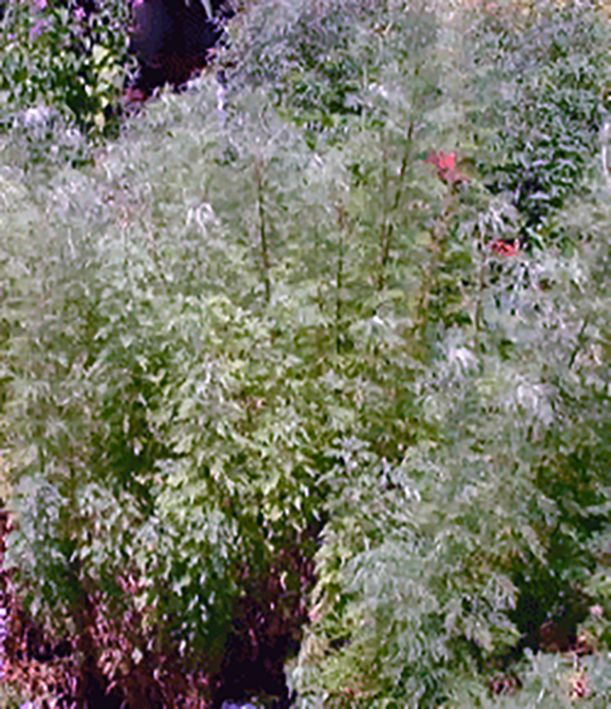 Southernwood
Artemisia
abrotanum
plants..
Southernwood
Artemisia
abrotanum
plants..
Welcome to the summary page for FabulousFusionFood's Herb guide to Southernwood along with all the Southernwood containing recipes presented on this site, with 1 recipes in total.
e This is a continuation of an entire series of pages that will, I hope, allow my visitors to better navigate this site. As well as displaying recipes by name, country and region of origin I am now planning a whole series of pages where recipes can be located by meal type and main ingredient. This page gives a listing of all the Cornish recipes added to this site.
These recipes, all contain Southernwood as a major herb flavouring.
Southernwood, Artemisia abrotanum (also known as Old Man, Boy's Love, Oldman Wormwood, Lover's Plant, Appleringie, Garderobe, Our Lord's Wood, Maid's Ruin, Garden Sagebrush, European Sage, Lad's Love, Southern Wormwood and Lemon Plant) is a flowering plant and a member of the Asteraceae (aster) family that's native to Europe and Britain. It's a close relative of wormwood and forms a small bushy shrub with narrow, feathery, grey-green leaves and small yellow flowers.
The leaves of the plant are used as an herb and have a strong fragrance (which can put many people off) and which has a lemony overtone. However, the leaves are quite bitter and need to be used in moderation (but is much less bitter than wormwood). It is commonly grown as a garden plant and it's reportedly used as a flavouring for cakes in Italy (though I have not yet found a recipe). The best use I have found is to tie a small sprig into a bouquet garni which can be used with fatty meats such as pork, duck, goose and mutton). Use sparingly, however, otherwise the bitterness can come to dominate.
There are two different cultivated strains of southernwood, both of which have a strong fragrance, which many people find unpleasant even in small quantities. The traditional type is vaguely reminiscent of lemon but the more recent cultivar "camphor southernwood" has an even more intense and dominant camphorous odour. Both types are well suited for culinary use, despite significant bitterness.
The pungent, scented, leaves and flowers are used in herbal teas. Young shoots were used to flavour pastries and puddings. In Italy, it is used as a culinary herb, particularly the young, lemony, shoots in salads and vinegars.
e This is a continuation of an entire series of pages that will, I hope, allow my visitors to better navigate this site. As well as displaying recipes by name, country and region of origin I am now planning a whole series of pages where recipes can be located by meal type and main ingredient. This page gives a listing of all the Cornish recipes added to this site.
These recipes, all contain Southernwood as a major herb flavouring.
Southernwood, Artemisia abrotanum (also known as Old Man, Boy's Love, Oldman Wormwood, Lover's Plant, Appleringie, Garderobe, Our Lord's Wood, Maid's Ruin, Garden Sagebrush, European Sage, Lad's Love, Southern Wormwood and Lemon Plant) is a flowering plant and a member of the Asteraceae (aster) family that's native to Europe and Britain. It's a close relative of wormwood and forms a small bushy shrub with narrow, feathery, grey-green leaves and small yellow flowers.
The leaves of the plant are used as an herb and have a strong fragrance (which can put many people off) and which has a lemony overtone. However, the leaves are quite bitter and need to be used in moderation (but is much less bitter than wormwood). It is commonly grown as a garden plant and it's reportedly used as a flavouring for cakes in Italy (though I have not yet found a recipe). The best use I have found is to tie a small sprig into a bouquet garni which can be used with fatty meats such as pork, duck, goose and mutton). Use sparingly, however, otherwise the bitterness can come to dominate.
There are two different cultivated strains of southernwood, both of which have a strong fragrance, which many people find unpleasant even in small quantities. The traditional type is vaguely reminiscent of lemon but the more recent cultivar "camphor southernwood" has an even more intense and dominant camphorous odour. Both types are well suited for culinary use, despite significant bitterness.
The pungent, scented, leaves and flowers are used in herbal teas. Young shoots were used to flavour pastries and puddings. In Italy, it is used as a culinary herb, particularly the young, lemony, shoots in salads and vinegars.
The alphabetical list of all Southernwood recipes on this site follows, (limited to 100 recipes per page). There are 1 recipes in total:
Page 1 of 1
| Erbolat Origin: England |
Page 1 of 1